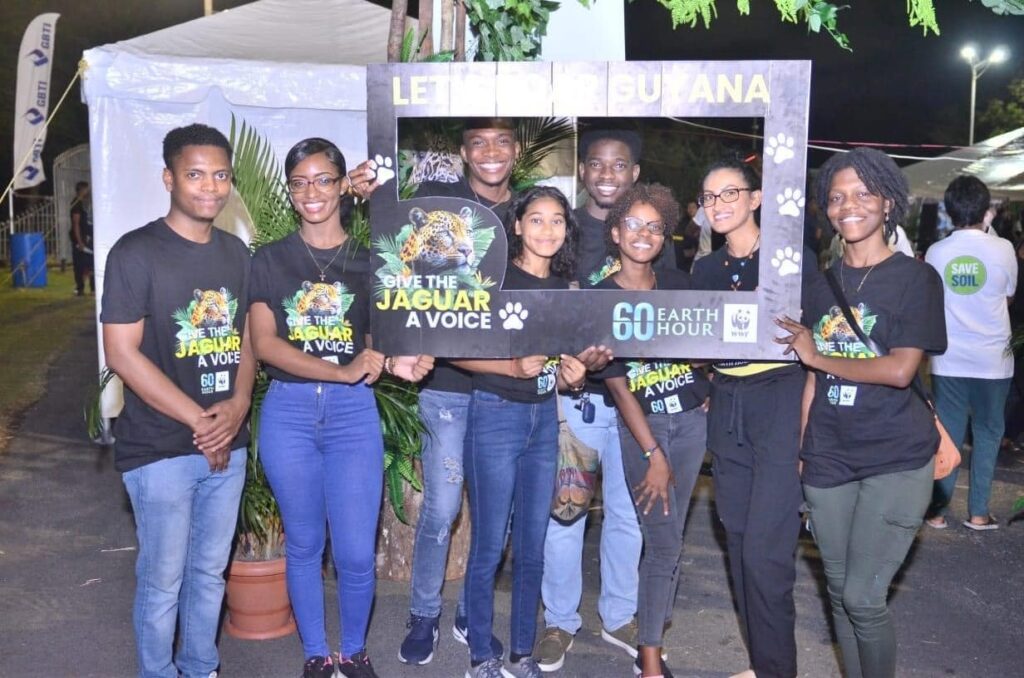
Gov’t committed to biodiversity conservation through global partnerships – Foreign Secretary
Foreign Secretary at the Ministry of Foreign Affairs and International Cooperation, Robert Persaud says the government’s Low Carbon Development Strategy (LCDS) 2030 and collaborations with the wildlife-focused groups highlight its commitment to biodiversity conservation through global partnerships.
Persaud gave remarks at an event to observe Earth Hour 2023 held at the National Park, Carifesta Avenue on Saturday.
The World Wildlife Fund (WWF), the Protected Areas Commission, corporate entities and government agencies coordinated the event with a focus on the “Give the Jaguar a Voice” initiative.
This initiative symbolises Guyana’s efforts to highlight the conservation of the species which plays a tremendous role in maintain the health of the planet.

Earth Hour is a global movement that started 15 years ago to raise awareness on specific global conservation issues and to give humans an opportunity to come together for global action for at least 60 minutes, doing something significant to help Earth.
“The Protected Areas Commission and the Government of Guyana remains committed to providing leadership in the global fight against biodiversity loss and climate change.
“We will continue to work together with our partners, like WWF, to gain national support for jaguar conservation. Let us collectively work together to advance the cause of Jaguar conservation in Guyana and across the world,” the Foreign Secretary said as he encouraged persons to commit to saving the Earth.
Persaud said that the government has taken action for conserving the forests and wildlife and its major contributor is the LCDS 2030 which identified biodiversity and ecosystem services as the key focus to Guyana’s economic growth, sustainable development, and human well-being.

This national strategy will ensure that these resources are “valued, conserved, and managed effectively.
“It is the intention of Government, through the LCDS 2030, to expand the protected areas system initially to 17% by 2025 and progressively to 30% by 2030. This would potentially allow for greater focus on species conservation including expanding Jaguar Corridors and creating space for nature to thrive,” Persaud said.
A major concern for the jaguar species is the killing and severe injuries due to habitat loss, human-wildlife conflicts and poaching. In Guyana, the Wildlife Commission and the government has over the years nurtured some of the severely injured Jaguars back to life at the Zoo, which now functions as a Wildlife Rescue, Rehabilitation and Education Center.
Additionally, the Protected Areas Commission has a significant responsibility in managing Guyana’s protected areas by working towards a world class protect Area’s systems that protects nature and improves lives. It is currently conducting research in the Protected Areas (PAs) particularly in the Kanuku Mountains and Shell Beach to determine the state of jaguar populations. Initial results suggest that there are healthy populations in these PAs.
The National Protected Areas System, which currently comprises of approximately 8.4 per cent of Guyana’s landmass, includes: the Iwokrama Forest (which was established by separate legislation), the Kaieteur National Park, Kanashen Amerindian Protected Area, the Kanuku Mountains Protected Area, the Shell Beach Protected Area and urban Parks including the National Park, the Botanical Gardens, the Zoological Park, and the Joe Vieira Park.
Already, more than 1.8 million hectares of forest are currently under formal protection which gives Guyana a unique opportunity to ensure that the habitat and general well-being of the Jaguar is maintained.






